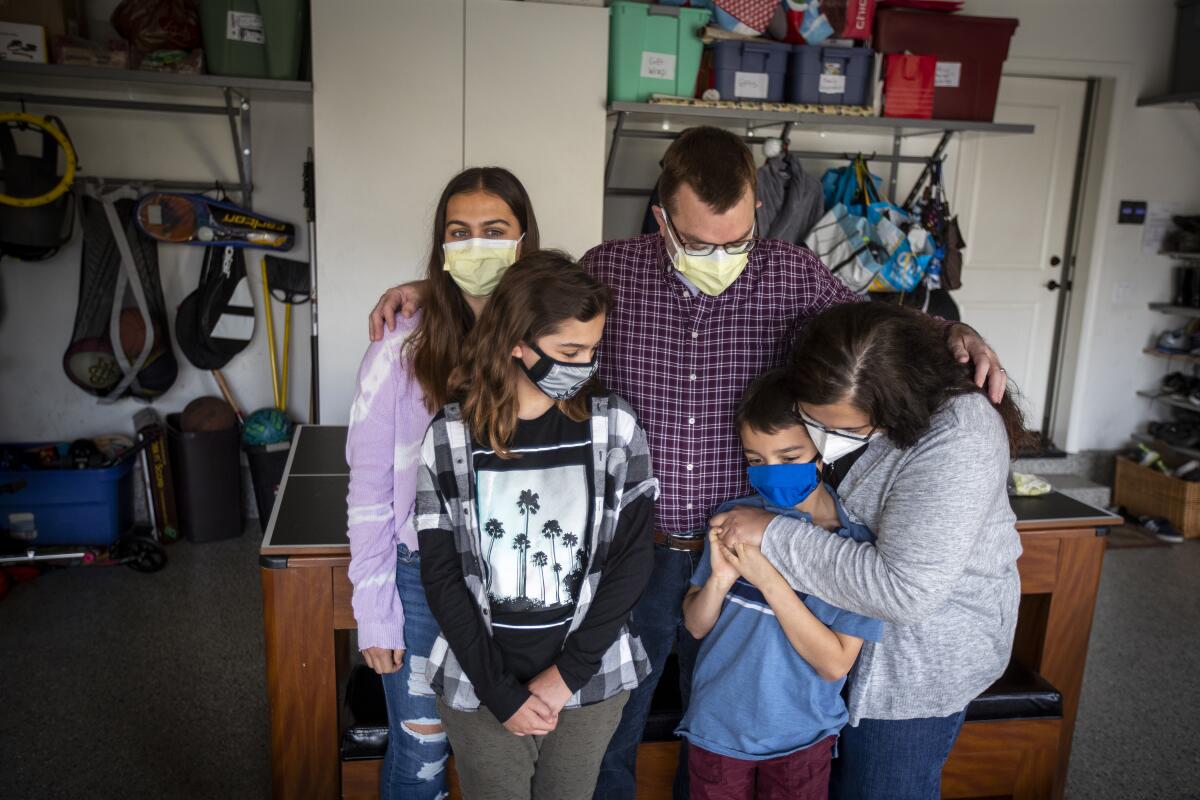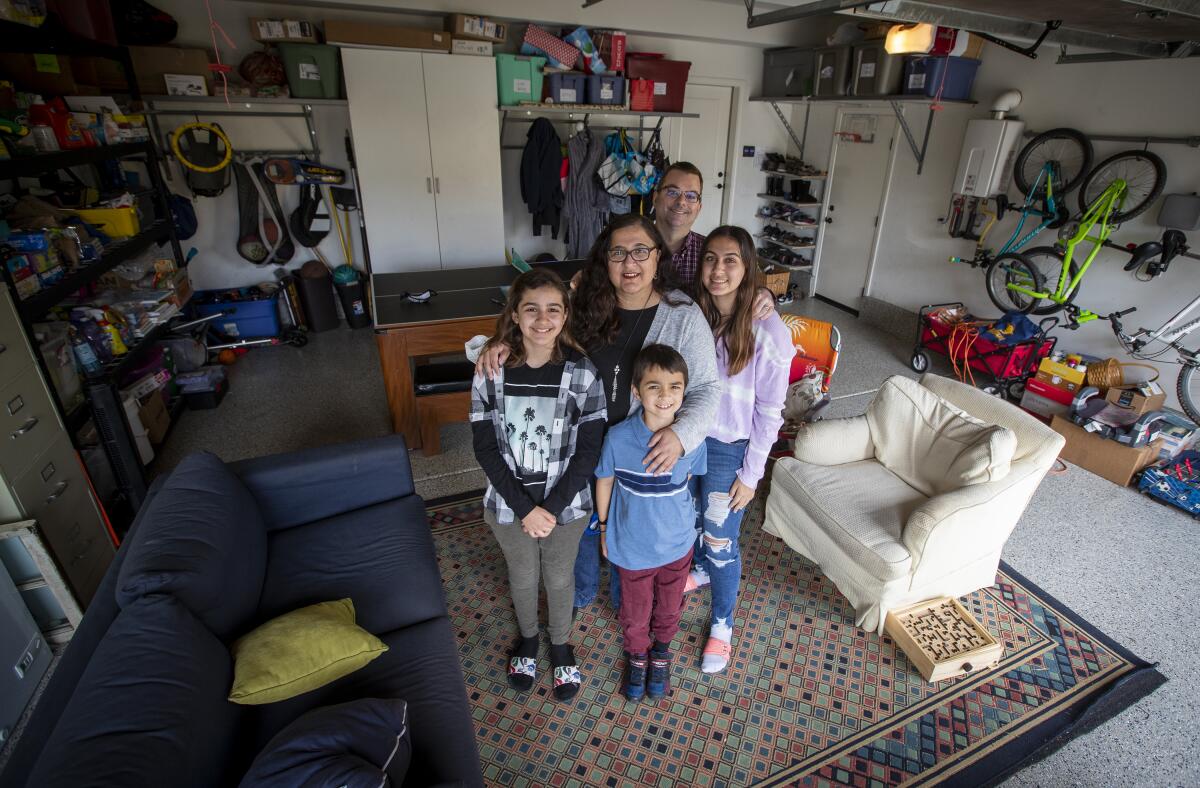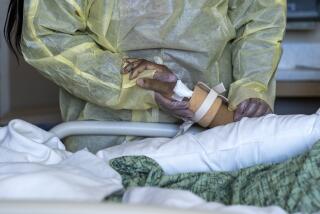A doctor left her family for a year to protect them from COVID-19. Now, she’s back home

- Share via
We’ve all made sacrifices during the pandemic. But physician Bobby Sasson, who was exposed daily to the threat of COVID-19 in her job at a UC Irvine medical center, made a particularly difficult one last spring.
For the protection of her husband and three young children, she moved out of the family house. At the time, she thought she’d be able to return home before long.
But that didn’t work out.
Let’s go back to March of 2020, the early stages of the pandemic. With a diabetic husband and kids who were 13, 9 and almost 7 at the time, Sasson was playing it as safe as she could, but she still worried about what she might bring home.
“I realized I could be a vector of the illness,” said Sasson, who practices internal medicine.
At first, she hoped that taking precautions around her family would be enough. She’d get home, change in the garage, shower immediately and wear a mask in the house.
Her husband, UC Irvine history professor Andrew Highsmith, was on sabbatical, writing a book on healthcare inequality, a topic that would soon be in the headlines across the nation, and when early evidence a year ago suggested that people with underlying conditions like his diabetes were particularly hard hit by the virus, Sasson began to wonder if her precautions were enough.
In late March, the couple’s middle daughter, Mira, developed what appeared to be COVID-19 symptoms. Mira, the kind of kid who was seldom sick, had a fever and her chest hurt. Her test came back clean, but Mira’s pediatrician — and her mother — suspected it was a false negative.
It was around this time that body bags were being loaded into portable freezers in New York because morgues were overwhelmed. Hospitals were in crisis, with front-line medical staff among the casualties. California hadn’t yet been hit as hard, but in early April, I wrote about three emergency room doctors at Good Samaritan Hospital who rented a house together because they were afraid to go home after work and possibly pass the virus on to their wives and young children.
In Irvine, Sasson and Highsmith eventually pulled their kids out of all social activities with other kids. They were particularly concerned because Orange County was emerging as a center of mask and shutdown resistance, marking the beginning of what would become one of the movements behind a recall effort against Gov. Gavin Newsom.
Highsmith said it was difficult to explain to their children why some people weren’t being cautious, which had the effect of putting their mother at greater risk. On a rare outing with the kids last spring, Highsmith said, they went for a drive “just to get out of the house” and came upon an anti-mask rally.
“I can remember how disappointed the kids were to see that and realize not everyone felt the need to make the same sorts of sacrifices,” he said.
After much thought and family conversation, Sasson and Highsmith made a heart-breaking decision. On April 11, she moved out of the family home near the UCI campus to live in a nearby apartment until the coast was clear.
“Everyone felt deep sadness about the decision,” Highsmith said, but even the kids thought it was the right thing to do. They all just hoped they wouldn’t be apart for long.
“I signed a lease for a month,” said Sasson. “And at the end of that, I said, ‘Hey, can I sign for another month?’”
And another, and another.
“It was difficult because I’d see other kids hug their moms,” said Aneel, the youngest of the three children.
But the separation proved to be a wise choice. In June, Sasson tested positive for COVID-19. She was asymptomatic but forced to quarantine. So for a brief time, she was separated from both her family and her job.
The entire ordeal was tough on all of them, Highsmith said. But as someone whose expertise includes public health, he was mindful that low-income families of color — many of them living in high-density homes and facing great risk as essential workers — didn’t have the luxury of isolating.
Still, Highsmith essentially became the single parent of three young children who had gone remote at school and sorely missed their mother as much as she missed them. He ordered grocery deliveries, prepared meals, and early on, the family fell into a routine that made the sacrifice more bearable.

Each night after work, Sasson would go to the house rather than her apartment. Her husband and kids would open the garage door, and dinner was served. Highsmith and the kids ate at a ping-pong table in the garage, and Sasson enjoyed her meals sitting on a chair in the driveway, 15 feet away.
Thank God for California’s climate, said Sasson and Highsmith, both of whom are from the Midwest. After dinner, the whole family went for a nightly walk in the neighborhood, with Sasson either leading the pack like a mother duck, or trailing behind the ducklings at a safe distance.
Even though Sasson had antibodies in her system from having had COVID-19, there were still enough mysteries about transmission that she wasn’t prepared to risk exposing her family. So this went on through the summer and into the fall and early winter.
Sasson was fully vaccinated in January, and Highsmith got his second shot in late March. As the picture brightened in California and beyond, they began to think about finally dropping the apartment lease.
The big day was a week and a half ago.
“When she came to the front door, at first I thought, ‘Oh, my God, is it safe to hug her?’” said Asha, the eldest child.
But they were all swept up in the moment, and didn’t hold back.
“We were super happy, laughing and crying,” said Asha.
Last Wednesday evening, as the family gathered in the backyard, Mira said she had a message for everyone who wore a mask and took other precautions, including getting vaccinated.
“Thank you,” Mira said, because doing the right thing helped make it possible for her family to be reunited.
And those who are ignoring the guidance of public health officials should reconsider, Mira said, because we can end the threat sooner by doing the right thing.
Mira’s mom seconded that notion. She said she trained in Michigan, where a fourth COVID wave is surging.
“I personally am a bit terrified,” Sasson said, about what will happen in California if we rush to return to normal before it’s safe to do so. “If we let our guard down, we’re going to be back in trouble again.”
For now, though, her family is celebrating her return.
“It’s been a long hard year,” Highsmith wrote on social media when his wife came home. “I don’t even have the words to describe how amazing it feels to be back together. Bobby, thank you for making this sacrifice to keep us safe. We love you with all our hearts and will be forever grateful for what you’ve endured for us and the community. You are our hero. Welcome home!”
Steve.lopez@latimes.com
More to Read
Sign up for Essential California
The most important California stories and recommendations in your inbox every morning.
You may occasionally receive promotional content from the Los Angeles Times.














